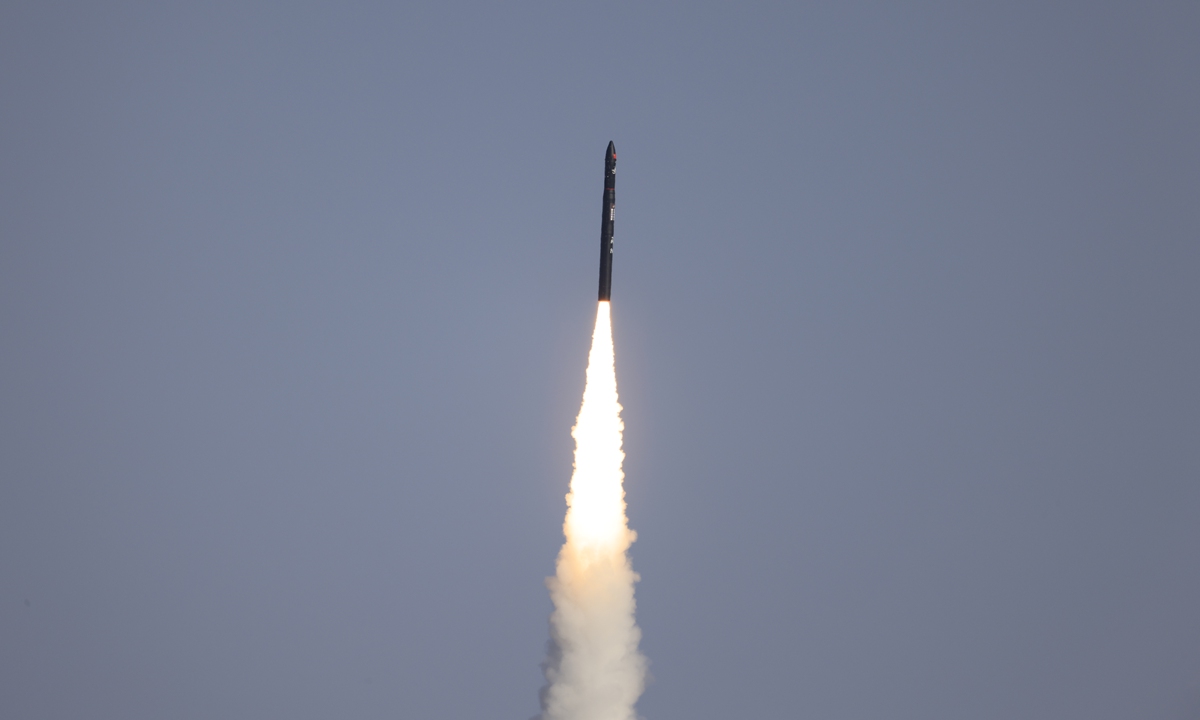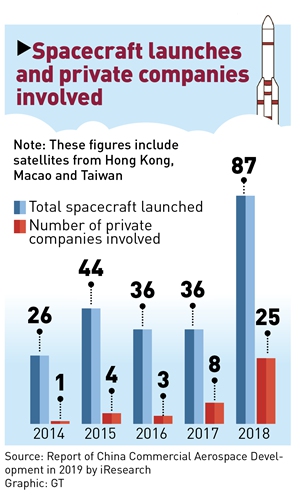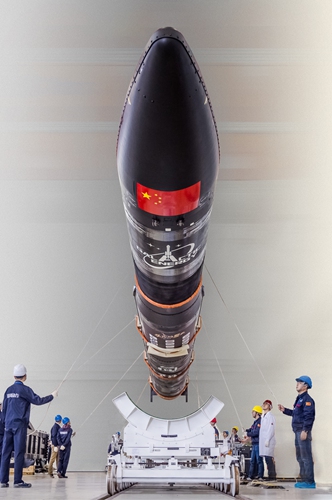Chinese private space firms gaining ground in orbital satellite launch
By Zhang Hongpei in Jiuquan Source: Global Times Published: 2020/11/8 17:58:41
Second firm successfully sends a satellite into orbit

Galactic Energy successfully launched the carrier rocket and put a satellite into orbit from the Jiuquan Satellite Launch Center in Northwest China's Gansu. Photo: Courtesy of Chen Xiao
Standing alone in the Gobi Desert in Northwest China, a small, black rocket, developed by a private Chinese aerospace firm, awaited its debut. The engineering team behind the rocket, who have worked around the clock for the past few months, was waiting, nervously, for the launch.
At 3:12 pm on Saturday, Chinese private rocket firm Galactic Energy successfully launched a carrier rocket and put a satellite into orbit from the Jiuquan Satellite Launch Center. The success marks the first orbital launch by a privately funded Chinese firm since the outbreak of the COVID-19 pandemic.
Named Ceres-1, the self-developed carrier rocket sent an Apocalypse-11 satellite into a 500-kilometer sun-synchronous orbit (SSO), with Galactic Energy becoming the first private Chinese firm to reach this altitude.
The Ceres-1 rocket is the first solid-propellant launch vehicle from Galactic Energy and is the main carrier rocket type for narrow-band Internet of Things (IoT) network construction and constellation supplement launch.
As one of a series of small Chinese experimental Low Earth Orbit (LEO) satellites, dubbed the Apocalypse constellation, which is operated by Beijing Guodian Gaoke Technology Co for IoT communications, the Apocalypse-11 satellite will perform the role of providing commercial data acquisition and transmission services in orbit.
The launch on Saturday takes the number of operational Apocalypse satellites in orbit from eight to nine. The Apocalypse Constellation is composed of 38 satellites and deployment is expected to be completed by the end of 2021.
The move demonstrated that China's private commercial space sector is becoming technologically mature and increasingly capable of handling satellite launch missions, even during the pandemic, observers said.
For China's private rocket firms, the ability to successfully send a carrier rocket to orbital altitude, which has a high technological threshold, has become the real test in a booming commercial space race.
China is the third country to see its private firms realize orbital launch, following the US and New Zealand.

The successful launch not only marked a milestone for Galactic Energy, but also strengthened confidence in the domestic commercial space industry, especially for private players, Huang Zhicheng, an expert in the space industry, told the Global Times.
Private firms, mostly start-ups, have withstood the economic impacts of the COVID-19 pandemic, and have continued to advance their research and development to further enhance their launch capabilities, Huang said.
The launch has also proved to investors a demonstration of the huge potential and business value in the emerging sector, despite these private companies still being in their infant development phase, he added.
Zhang Zhanshi, investment director at Kexin Capital, told the Global Times at the launch scene on Saturday that the private space force sees huge potential in future market applications, and that the scope is so large that is hard to imagine.
With further construction of LEO satellites, which could amount to thousands in the future, many opportunities will appear for private players to participate in China's rising commercial space sector, Zhang noted.
With satellite internet added onto a list of the nation's "new infrastructure" master program in April, China's commercial satellite sector is also growing. Space start-up funding is growing, with accumulative financing of around 2.86 billion yuan ($430 million) having been raised so far.
Galactic Energy has recently secured its A round of financing worth 200 million yuan ($30.22 million). The money will be used for the research and development of Pallas-1, its liquid-propellant rocket, as well as building up the mass production capability for its Ceres-1 rocket, the company said.

Ceres-1, the self-developed carrier rocket from Chinese private rocket firm Galactic Energy Photo: Courtesy of Chen Xiao
Advance for liquid propellant
The commercial space sector has become one of the key battlegrounds for the world's powers to compete. China opened the sector to private players back in 2014 with a long-term ambition to integrate the civil and military sectors. Private players are seen as an indispensable force in the race, with capabilities in low-cost and high-efficiency development and production.
Prior to the Galactic Energy launch in Jiuquan, there have been three orbital launch attempts by leading players in the domestic private commercial space sector, with two failures and one success.
In July 2019, Chinese rocket firm iSpace's carrier rocket successfully sent satellites into orbit from the Jiuquan Satellite Launch Center, the first private space firm to do so.
Early rocket pioneer OneSpace failed to send a satellite into orbit in March 2019, due to the malfunction of its OS-M rocket's rate gyroscope. Another private rocket maker, LandSpace, failed its maiden orbital launch in October 2018, due to an abnormality occurring during the rocket's third stage, rendering the cargo unable to reach its target orbit.
The successful orbital launches by iSpace and Galactic Energy are attributable to their self-developed rockets equipped with solid propellant, which is significantly more technologically mature than liquid propellant, however, the latter is now the trend, experts said.
Lan Tianyi, founder of Beijing-based Ultimate Blue Nebula Co, a space industry consultancy, told the Global Times that as a stepping stone for each player, the solid-engine rocket has completed its historical mission to some extent.
"In the future, those start-ups will work toward liquid-engine rockets with higher technical difficulties, greater costs, and better commercial prospects," Lan said.
LandSpace is usually dubbed as the Chinese answer to SpaceX, as from day one it aimed to break technology barriers and achieve high-reliability and low-cost medium-sized and large liquid rocket products. The company has also taken the lead in the development of liquid-oxygen methane engines.
SpaceX's Falcon 9 rockets rely on a combination of liquid oxygen and rocket-grade kerosene propellant.
The reusable liquid-oxygen methane engine, independently developed by iSpace, has gained the ability of secondary starting and large-scale continuous variable thrust. It is the key to recovery and reuse of the launch vehicle.
According to Galactic Energy's plan, by 2021, Ceres-1 mass production will be gradually scaled up, and its liquid- propellant Pallas-1 rocket is scheduled to be sent into orbit in 2022.
Newspaper headline: China’s private space sector grows
Posted in: INDUSTRIES,COMPANIES,BIZ FOCUS